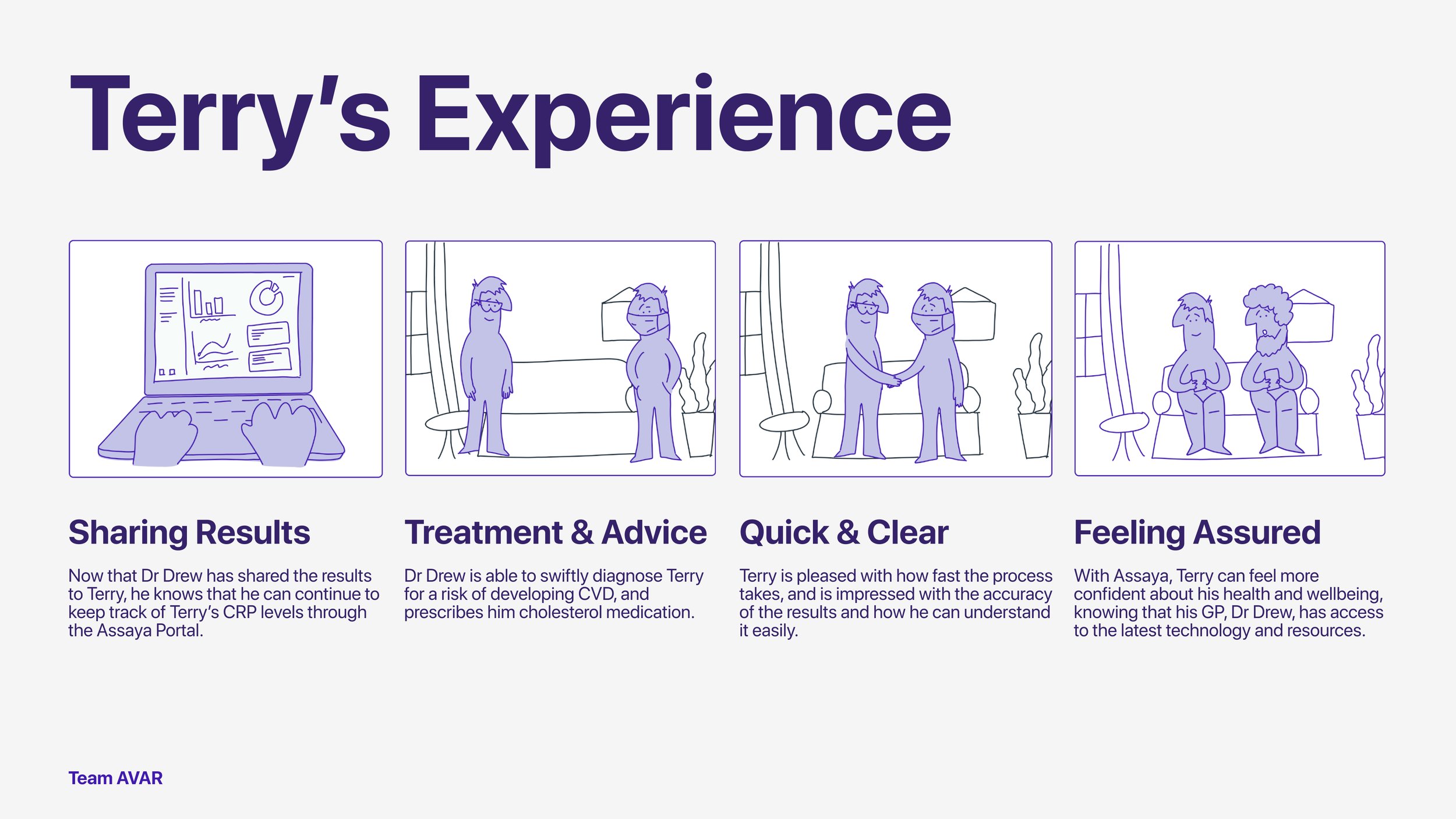

Project
Client Project - UX/UI Webpage Design
Timeline
6 weeks
My Role
UX/UI Designer
Tools
Figma, Miro, Procreate, Trello
Methods
Desktop research, One to One Interview, Competitor Analysis, Affinity/Empathy Mapping, Crazy 8s & Ideation, Wireframing, Prototyping, Presenting
CLIENT BRIEF
Assaya, Revolutionizing global diagnostics for rapid disease prevention and control
Assaya, a diagnostics company based in Taiwan, utilizes UQLFA (Universal Quantitative Lateral Flow Assay) for conducting various tests including diseases, pregnancy, and food safety. Going beyond simple positive or negative results, Assaya delivers precise data promptly, with the added benefit of offline capability in remote regions. Assaya's cloud interface serves as the main platform for users to access and evaluate their data, offering a centralized approach to diagnostics.

THE CHALLENGE
Limited access to medical care in rural areas hampers accurate and prompt diagnosis and treatment of patients, particularly those with preventable diseases
Individuals residing in rural and remote areas confront unique health challenges stemming from their living conditions, social isolation, socioeconomic status, and limited access to services. Unfortunately, the health status of rural and remote populations in Australia lags behind urban counterparts, with higher disease rates and poorer health outcomes.
Based on the client brief, Assaya is targeting researchers and specialized diagnostic hospitals. To maximize effectiveness, user segmentation and thorough research would be conducted to define the project's problem. Our focus would be on cardiovascular diseases in rural Australia, which should also be beneficial to Assaya overall user experience
Assaya has the biggest frustration with the two interfaces
Revamping the UI/UX of Assaya's portal, which currently utilizes a grid view with numerous columns for multiple test results, to optimize usability.
Enhancing flexibility in the current UI to support a wider range of tests, ensuring ease of use for clinicians.
Striking a balance between improved information presentation and maintaining result accuracy as per Assaya's expectations.
OUR GOAL
Transforming Assaya Portal
Enhance the usability and design of Assaya's portal, ensuring an intuitive and user-friendly interface for clinicians.
Empower rural medical clinicians to improve the diagnosis of preventable diseases and deliver prompt treatment to patients.
Streamline the management of blood test results and patient diagnosis through a cohesive and user-friendly interface.

CONSTRAINTS
What are considerations?
Ensure the accuracy of blood test results during the implementation of new features and interface changes.
Adhere to stringent privacy and security regulations to safeguard sensitive patient data.
Address the challenges posed by limited access to Assaya's customer base, which may restrict user feedback and testing opportunities.
THE PROBLEM
The high prevalence of preventable diseases in low-socio-economic areas highlights the need for effective preventative health screening. Medical clinicians rely on cloud interfaces to diagnose chronic conditions, such as diabetes and coronary heart disease.
Improvements to the user interface and information architecture of the Assaya portal is necessary to ensure efficient presentation and comprehension of blood test results for effective diagnosis and treatment.

THE SOLUTION
01 I Assaya for GPs & Clinicians
02 I Assaya for Internal Admins
Let me walk through how We came up with The Solution
PLANNING & PROJECT TIMELINE
RESEARCH METHODS

DESKTOP RESEARCH
Understanding Point-of-care Testing
As a unique selling proposition, Assaya's devices offer an optimal method to analyze and detect emerging patterns of existing outbreaks like COVID-19.
Surpassing traditional PCR machines commonly found in diagnostic labs during the pandemic, Assaya's devices have the potential to serve as replacements in rural areas, allowing clinicians and patients to conduct near-testing or bedside testing and obtain specific data within a remarkable timeframe of approximately 3 seconds, compared to the typical 10 minutes with other devices.
Point-of-care testing represents the fastest-growing sector in the global pathology industry, with projected global market sales expected to exceed USD$30.9 billion by 2024.
Understanding Coronary heart disease (CVD) in Australia rural areas
Key Statistics
Common Tests for CVD
In order to generate innovative solutions for displaying test result information, we conducted extensive desktop research focused on common tests for cardiovascular disease (CVD), such as CRP (C-reactive protein) and cholesterol tests. Our research primarily focused on test result interpretation, aiming to gain insights that would inform the development of effective and user-friendly display solutions.
COMPETITOR ANALYSIS
Considering table customisation and device compatibility as Assaya’ potential opportunities
Based on our understanding of Assaya's strengths and weaknesses, we conducted an analysis of three competitors, with a particular focus on Information Architecture as our priority criterion. Among the competitors, NeoSync stood out as a main direct competitor, offering a connectivity solution for point-of-care (POC) testing devices. By identifying the flaws that current competitors are grappling with, we have identified opportunities for Assaya to capitalize on and address in order to gain a competitive edge.
NeoSync
Siemens
PathWest

1:1 INTERVIEWS
What Clinicians are saying?
To gain deeper insights into the current challenges faced by clinicians, we conducted interviews with healthcare professionals working directly in hospitals based in Australia. These interviews provided valuable firsthand information regarding the specific difficulties clinicians encounter in their day-to-day practices, enabling us to better understand their needs and tailor solutions accordingly.
"I want to use precious time to help sick patients, and not waste time searching for patient data”
“I want to make sure I’m interpreting these results accurately, it would help a lot to have a data summary for each patient, while considering their details and medical history”
Due to challenges encountered in collecting insights from other clinicians, we combined the available data with our desktop research, leading to the identification of three key themes. These themes represent significant areas of concern and provide valuable insights into the challenges faced by clinicians in their professional settings.
EMPATHY MAPPING
What are impactful insights?
To synthesize qualitative data and develop a comprehensive understanding of the challenges and benefits associated with accessing test results for treating preventable diseases, an empathy mapping exercise was conducted to empathize with both clinicians and patients.
With the key themes identified, we have gained valuable insights into the significant challenges encountered by clinicians in their professional settings, providing a foundation for impactful solutions.

HOW MIGHT WE
We posed this question
How might we leverage Assaya’s cloud interface to improve CVD care for rural communities, resulting in timely diagnosis and treatment for individuals increased risk of coronary heart disease?
STORYBOARD

USER FLOW
BRANDING
Explore new logo concepts incorporating various triangle shapes with gradient colours to create an animated effect.
Develop another mockup with the logo text and branding statement using a midnight purple colour scheme.
Create a mockup featuring the logo text and branding statement using a blue colour scheme.
Finalise the branding logo by selecting the most suitable design.
STYLE GUIDES

During the design stage, I contributed by sketching out ideas on how to present test results in table views, emphasizing the customizability through filter features and incorporating a cumulative chart. Additionally, I explored ways for users to navigate historical medical records. Valuable feedback from my team members helped me refine and adjust my sketches to incorporate their suggestions into the wireframing process.
SKETCHES
WIREFRAMING
Improvements from low-fi to high-fi wireframes
Dashboard - What data demands clinicians’ immediate attention?
Simplified statistics section with a focus on priority tests and pending follow-ups.
Streamlined patient's test result table by prioritizing result status and adding a button to view test details for each patient.
Removed unnecessary sections to create a clean and straightforward dashboard design.
Patients - Customize Table View with Ease
Removed filter icon on each row title in the patients table view and introduced a filter feature for users to easily customize the table without navigating each row.
Moved historical medical records and notes into the patient details page to allow clinicians to manage all information related to specific patients in one place.
Test results - Empowering Patients with Interpretation
Implemented separate layouts for the result report, tailored to the needs of clinicians and patients. The clinician report includes detailed medical numeracy, while the patient report focuses on providing general interpretations for easy understanding of their health status
Enabled sharing and export functionalities for both reports, allowing convenient access and seamless communication between healthcare professionals and patients.

FINAL PROTOTYPE
What I have learnt
Overall, this project provided valuable insights into the collaborative design process, research-driven problem-solving, bridging gaps in UX/UI, and the importance of user-centric design.
Defining key focus areas through collaborative efforts
Being part of a talented team allowed for effective collaboration, discussion, and skill-sharing throughout the research and design stages. Initially, understanding the diagnostic device and envisioning the cloud platform for result delivery presented challenges, but through teamwork, we were able to define the main focus areas for improving Assaya's interface.
Bridging the gap in user experience
Assaya had limited experience in UX/UI design, and this project provided an opportunity to bridge that gap. Through competitor analysis, we identified areas for improvement and proposed solutions that would enhance the user experience, making the interface more intuitive, user-friendly, and efficient.
Iterative problem-solving
The project underscored the significance of gathering and incorporating feedback from various perspectives. Feedback from team members and our mentor provided valuable insights and helped us identify areas for improvement, particularly in scoping project, designing the dashboard and result layout report.
Engaging storytelling in presentation
One valuable skill I learned from my team members was the art of simplified storytelling in presentations. They were able to effectively summarize our project journey by focusing on the problem, the solutions we proposed, and showcasing the prototypes and final user experiences. This skill made our storytelling more engaging and interesting, allowing us to effectively communicate our project's key points to the clients.
Thank you for reading!

Would you like to explore my other projects?
Wellvana Medical Centre Website
A New Approach To Enhancing Patient Experience In Physical General Practice And On Digital Platforms.
Bz Listen Audiobook
Personalized Audiobook App for Busy Lifestyles









































